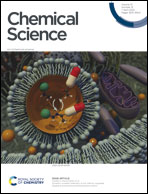DFT insight into asymmetric alkyl–alkyl bond formation via nickel-catalysed enantioconvergent reductive coupling of racemic electrophiles with olefins†
Abstract
A DFT study has been conducted to understand the asymmetric alkyl–alkyl bond formation through nickel-catalysed reductive coupling of racemic alkyl bromide with olefin in the presence of hydrosilane and K3PO4. The key findings of the study include: (i) under the reductive experimental conditions, the Ni(II) precursor is easily activated/reduced to Ni(0) species which can serve as an active species to start a Ni(0)/Ni(II) catalytic cycle. (ii) Alternatively, the reaction may proceed via a Ni(I)/Ni(II)/Ni(III) catalytic cycle starting with a Ni(I) species such as Ni(I)–Br. The generation of a Ni(I) active species via comproportionation of Ni(II) and Ni(0) species is highly unlikely, because the necessary Ni(0) species is strongly stabilized by olefin. Alternatively, a cage effect enabled generation of a Ni(I) active catalyst from the Ni(II) species involved in the Ni(0)/Ni(II) cycle was proposed to be a viable mechanism. (iii) In both catalytic cycles, K3PO4 greatly facilitates the hydrosilane hydride transfer for reducing olefin to an alkyl coupling partner. The reduction proceeds by converting a Ni–Br bond to a Ni–H bond via hydrosilane hydride transfer to a Ni–alkyl bond via olefin insertion. On the basis of two catalytic cycles, the origins for enantioconvergence and enantioselectivity control were discussed.



 Please wait while we load your content...
Please wait while we load your content...